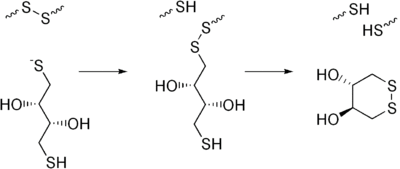A dithiol is a type of organosulfur compound with two thiol functional groups. Their properties are generally similar to those of monothiols in terms of solubility, odor, and volatility. They can be classified according to the relative location of the two thiol group on the organic backbone.
- Structure of Some Dithiols
The drug meso-2,3-dimercaptosuccinic acid
Dimercaprol ("British anti-Lewisite"), an early antidote for arsenic poisoning
Dihydrolipoic acid, a vitamin
Dithiothreitol, a reagent in protein biochemistry
Geminal dithiols
Geminal dithiols have the formula RR'C(SH)2. They are derived from aldehydes and ketones by the action of hydrogen sulfide. Their stability contrasts with the rarity of geminal diols. Examples include methanedithiol, 1,1-ethanedithiol, and 1,1-cyclohexanedithiol. Upon heating, gem-dithiols often release hydrogen sulfide, giving the transient thioketone or thial, which typically convert to oligomers.[1]
1,2-Dithiols
Compounds containing thiol groups on adjacent carbon centers are common. 1,2-Ethanedithiol reacts with aldehydes and ketones to give 1,3-dithiolanes:
- (HS)2C2H4 + RCHO → RCHS2C2H4 + H2O
Some dithiols are used in chelation therapy, i.e. the removal of heavy metal poisons.[2] Examples include dimercaptopropanesulfate (DMPS), dimercaprol ("BAL"), and meso-2,3-dimercaptosuccinic acid.
Enedithiols
Enedithiols, with the exception of aromatic examples, are rare. The parent aromatic example is benzenedithiol. The dithiol of 1,3-dithiole-2-thione-4,5-dithiolate2- is also known.
1,3-Dithiols
1,3-Propanedithiol is the parent member of this series. It is employed as a reagent in organic chemistry, since it forms 1,3-dithianes upon treatment with ketones and aldehydes. When derived from aldehydes, the methyne C-H group is sufficiently acidic that it can be deprotonated and the resulting anion can be C-alkylated. The process is foundation of the umpolung phenomenon.[3]
Like 1,2-ethanedithiol, propanedithiol forms complexes with metals:
A naturally occurring 1,3-dithiol is dihydrolipoic acid.
1,3-Dithiols oxidize to give 1,2-dithiolanes.
1,4-Dithiols
A common 1,4-dithiol is dithiothreitol (DTT), HSCH2CH(OH)CH(OH)CH2SH, sometimes called Cleland's reagent, for to reduce protein disulfide bonds. Oxidation of DTT results a stable six-membered heterocyclic ring with an internal disulfide bond.

References
- ^ Cairns, T. L.; Evans, G. L.; Larchar, A. W.; McKusick, B. C. (1952). "gem-Dithiols". Journal of the American Chemical Society. 74 (16): 3982–9. doi:10.1021/ja01136a004.
- ^ Rooney, James P.K. (2007). "The role of thiols, dithiols, nutritional factors and interacting ligands in the toxicology of mercury". Toxicology. 234 (3): 145–156. doi:10.1016/j.tox.2007.02.016. PMID 17408840.
- ^ Conrow, R. E.; Le Huérou, Y. (2004). "1,3-Propanedithiol". In L. Paquette (ed.). Encyclopedia of Reagents for Organic Synthesis. J. Wiley & Sons, New York. doi:10.1002/047084289X. ISBN 9780471936237.
2.svg.png)


